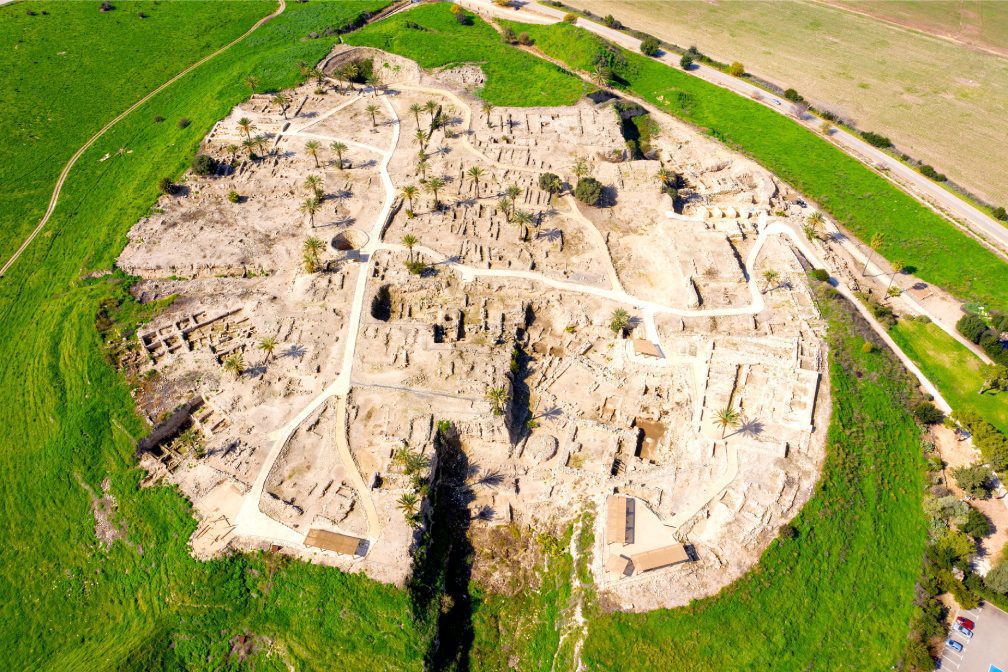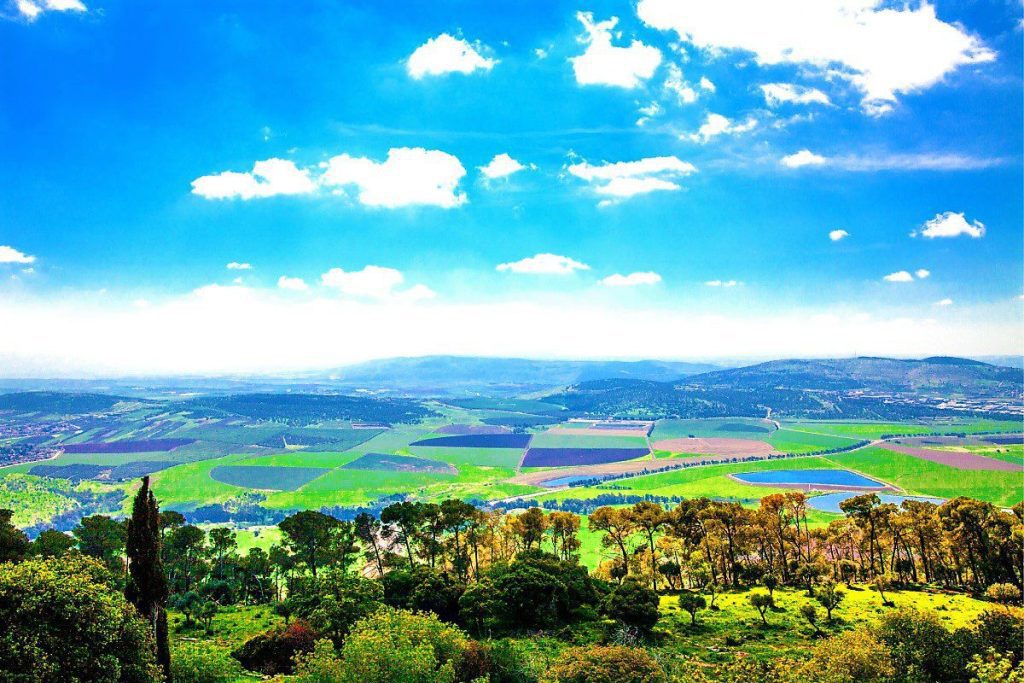The Battle of Megiddo, fought 15th century BCE, was between the Egyptian forces under the command of Pharaoh Thutmose III and a large rebellious coalition of Canaanite vassal states led by the king of Kadesh. In fact, it is the first battle to have been recorded in what is accepted as relatively reliable detail. Also, Megiddo is the first recorded use of the composite bow and the first body count. All details of the battle come from Egyptian sources. In other words, hieroglyphic writings on the Hall of Annals in the Temple of Amun-Re at Karnak, Thebes (now Luxor); by the military scribe Tjaneni.

TEL MEGIDDO ONE OF THE MANY BIBLICAL TELS IN ISRAEL
The First Battle Recorded in History with Reliable Detail
The Battle of Megiddo unfolds during the time of King Thutmose III’s first campaign in the Levant; his personal scribe, Tjaneni, kept a daily journal on parchment. In approximately his 42nd regnal year, many years after his campaigns in the Levant had ended; Thutmose III instructed his artisans to inscribe his military exploits into the walls of Amun-Re’s temple at Karnak. The annals describe in lavish detail 14 campaigns led by Thutmose III in the Levant; the booty gained through his campaigning; tribute received from conquered regions.

THE JEZREEL VALLEY WHERE THE BATTLE WAS FOUGHT
Additionally, the annals show the long-lasting effects of the battle of Megiddo. After Thutmose III’s victory at Megiddo and his successful campaigns in the Levant over the next 20 years; Egypt’s rise to power in the international community and its evolution into an empire is evident in the annals. Depictions show international diplomacy through the giving of gifts from Babylon; the Hittite Empire; and other prominent and powerful regions during this time period.
The Battle of Megiddo Begins With the Campaign Against the Kingdoms of Canaan
So Pharaoh Thutmose III began a reign in which the Egyptian Empire reached its greatest expanse by reinforcing the long-standing Egyptian presence in the Levant. After waiting impatiently for the end of his regency by the Egyptian Pharaoh Hatshepsut. In fact, he immediately responded to a revolt of local rulers near Kadesh in the vicinity of modern-day Syria. As Egyptian buffer provinces in the land of the Amurru along the border with the Hittites attempted to change their vassalage; Thutmose III dealt with the threat personally.
So the Canaanites are thought to have been allied with the Mitanni and Amurru from the region of the two rivers between the headwaters of the Orontes and the Jordan. In addition, the driving and main force behind this revolt were the King of Kadesh. The powerful fortress of Kadesh offered protection to him and the city. Including the King of Megiddo, with an equally strong fortress, joined the alliance. In general, the importance of Megiddo was its geographical location along the southwestern edge of the Jezreel Valley just beyond the Mount Carmel ridge and the Mediterranean. From this location, Megiddo controlled the Via Maris. In other words, it was the main trade route between Egypt and Mesopotamia.
The Preparations For the Battle of Megiddo
The Egyptian inscriptions of the campaign on the Temple of Karnak come from a daily journal kept by the scribe Tjaneni during the campaign. In the Egyptian account, Thutmose III gathered an army of chariots and infantry that numbered between ten and twenty thousand men. As the Egyptians mustered their forces, the king of Kadesh gathered many tribal chieftains from Syria; Aram, and Canaan around him. It is estimated at between ten and fifteen thousand; entered Megiddo and set his forces at the waters of Taanach. He expected that his enemy would come by the main route.
The Egyptian army assembled at the border fortress Tjaru and arrived ten days later at the loyal city of Gaza. After one day’s rest, it left for the city of Yehem; which was reached after 11 days. Here, Thutmose sent out scouts. To continue north, they had to pass the Carmel mountain ridge. Behind it lay the city and fortress of Megiddo; where the revolting forces had gathered. There were three possible routes from Yehem to Megiddo. Both the northern route; via Tel Yokneam, and the southern route, by way of Taanach, gave safe access to the Jezreel Valley.
Thutmose III decided to take the direct path to Megiddo
The middle route, via Aruna (modern Wadi Ara); was more direct but risky; it followed a narrow ravine, and the troops could only travel single-file. So if the enemy waited at the end of the ravine; the Egyptians would risk being cut down piecemeal. The army leaders pleaded with him not to take the difficult road but to take either of the two easier roads. Instead, with information from the scouts; Thutmose III decided to take the direct path to Megiddo. He believed that if his generals advised him to take the easy route; then his enemy would assume he would do so, so he decided to do the unexpected.
The King of Kadesh had left large infantry detachments guarding the two more likely paths and virtually ignored Aruna, the narrow mountain pass coming in from the south. Ignoring the danger of spreading out his army in the mountains where leading elements might be subject to enemy ambush in narrow mountain passes, and his main force still far behind in Aruna, unable to come to their aid, Thutmose took the direct route through Wadi Ara. To reduce the risk, Thutmose himself led his men through Aruna.
With his infantry and the light cavalry of mounted bowmen, known as haibrw or the horsemen going by the side of the mountains, to take out any scouts that might be posted and leaving the road to the main force of chariots, he moved in quickly. With the city lightly guarded by the enemy, Thutmose led a quick assault, scattered the rebels, and entered the valley unopposed. Now, the Egyptian army had a clear path to Megiddo, with large parts of the rebel army far away to the north and south.
Battle of Megiddo and siege
Thutmose seized the opportunity. He set up camp at the end of the day. But during the night arrayed his forces close to the enemy; the next morning, they attacked. It cannot be established if the surprised King of Kadesh had managed to fully prepare for battle. Even if he did, it did not do him much good. Though his forces were on high ground adjacent to the fortress; the Egyptian line was arranged in a concave formation; consisting of three wings; that threatened both Canaanite flanks.
Both the Egyptians and the Canaanites are estimated to have had around 1,000 chariots and 10,000 infantry. The Pharaoh led the attack from the center. The combination of position and numbers; superior maneuverability of their left-wing along with an early; bold attack, broke the enemy’s will; their line immediately collapsed. Those near the city fled into it, closing the gates behind them.
The Egyptian soldiers fell to plundering the enemy camp. During the plunder; they captured 924 chariots and 200 suits of armor. Unfortunately for the Egyptians; during this confusion, the scattered Canaanite forces, including the kings of Kadesh and Megiddo were able to rejoin the defenders inside the city. Those inside lowered tied-together clothing to the men and chariots and pulled them up over the walls. Thus, the opportunity of a quick capture of the city following the battle was lost.
The Siege
The city was besieged for seven months and the King of Kadesh escaped. Thutmose built a moat and a wooden palisade; eventually forcing its occupants to surrender. At Karnak, it is recorded that the victorious army took home 340 prisoners, 2,041 mares, 191 foals; 6 stallions; 924 chariots, 200 suits of armor, 502 bows, 1,929 cattle, 22,500 sheep; and the royal armor; chariot and tent-poles of the King of Megiddo. The city and citizens were spared. A number of other cities in the Jezreel Valley were conquered and Egyptian authority in the area was restored.
The Results of the Battle of Megiddo
As a result of the Battle of Megiddo, Egypt’s realm was expanded by this campaign. In fact, by reestablishing Egyptian dominance in Canaan; Thutmose began a reign in which Egypt reached its greatest expanse as an empire. Moreover, Thutmose III required from the defeated kings that they each send a son to the Egyptian court. So there, they received an Egyptian education. When they returned to their homelands, they governed with Egyptian sympathies. Nevertheless, the victory at Megiddo was only the beginning of the pacification of the Levant. Only after several further campaigns; conducted almost annually, was the unrest cooled. One unanticipated result came in the form of the word Armageddon, which took its root from Megiddo’s name.







